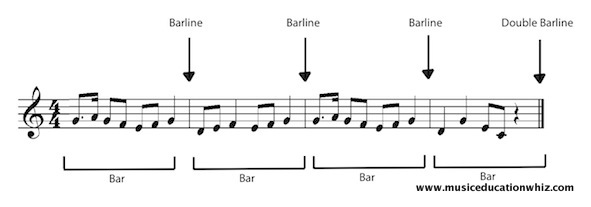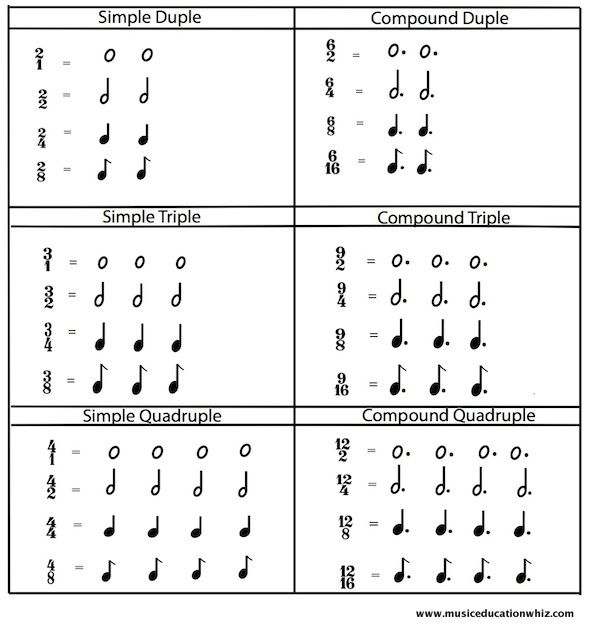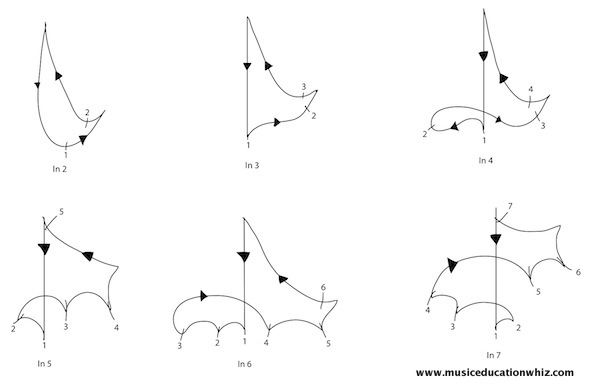Back to andrewdownes.com

Music Education
Resources by Paula Downes, a lot of music by Andrew Downes
Time Signatures clarified!
On this page:
Bars and barlines
Time Signatures
Meter
Simple and Compound
Irregular/Odd
The Anacrusis, upbeat or pickup
Conducting
Bars and barlines
We need to know that:
* Music is divided into bars.
* Bars are separated by barlines.
* At the end of a piece of music we have a double barline.
Every bar has the same number of beats in it, and we are told the number of beats
per bar by the time signature at the start of the music, which looks like this:

It occurs at the start of the music, after the
Clef and after the key signature:
The top number tells us how many beats
there are per bar.
The bottom number
tells us what kind of beats these are.
Watch the free video below to see and hear what 2/4 looks and sounds like:

1 at the bottom means semibreve/whole note
beats
2 at the bottom means minim/half note beats
4 at the bottom means crotchet/quarter note beats
8 at the bottom means quaver/eighth note
beats
16 at the bottom means semiquaver/sixteenth note
beats
We tend to stress the first beat of each bar as
you will hear in the free videos below.





And so on.




Return to the top of the page
Meter
We talk about music being in 2 time, 3 time, 4 time etc. This is the meter and is referring to the top number of the time signature, or the bigger beats in compound time (see below). It doesn't matter what the bottom number is. We call time signatures with 2 beats duple meter, with 3 beats triple meter, four beats quadruple meter, five beats quintuple meter, six beats sextuple meter, seven beats septuple meter etc.
Tips to help you recognize different meters:
* If the music is in two time you can march to it
* If the music is in three time, you can waltz
to it
Return to the top of the page
Simple and Compound Time
All time signatures with a 2, 3, 4, 5, 7, 10, 11
on the top are simple. The beats in simple time divide into 2.
For example:

All time signatures with a 6, 9, or 12 on
the top are compound. The big beats in a compound time signature divide into 3 smaller beats. The top number refers to the smaller beats.
For example:

Notice that 3/4 and 6/8 both contain 6 quavers per bar. The difference between the two is the way the quavers grouped, and therefore beamed. 3/4 is in 3/triple time, 6/8 is in 2/duple time.
Here is an example of each to highlight the difference:
Here is a table to show how simple and compound time relate to each other:
Return to the top of the page
Irregular/Odd
Time
An irregular/odd time signature subdivides into a combination of groups of twos and threes.
Examples of these have 5, 7, 8, 10, 11, or 13 at the top. The examples in the free videos below show groups of threes with triangles above the stave and groups of twos with a line above the stave. This is a common way for composers and performers to indicate groups of twos and threes in their scores.
Note that the groups of twos and threes in irregular/odd time can be in any order. For example, a piece in 5 can have a group of 3, then a group of 2 in each bar OR a group of 2 followed by a group of 3. The composer may even change the order during the piece.
Return to the top of the page
The Anacrusis, upbeat or pickup
A piece of music does not always have to begin on the first beat of the bar. Often music will begin on the last beat of the bar, or the last two or three beats of a bar. These are called 'upbeats', 'pickups' or 'anacrusis'. Here is are some examples:
Notice that the last bar in the examples above are not complete.
The sum of the beats in last bar and the first bar have to be equal to a complete bar when there is an anacrusis/pickup/upbeat.
Return to the top of the page
Conducting
Conductors beat time using the following patterns:
Conductors have to choose whether to beat in smaller beats or bigger beats depending on the speed of the music or the difficulty of the rhythms. For example they could beat 6/8 time in a fast 6 or a slow 2. They could beat 5/8 in 5 or in 3 then 2, or in an uneven 2. Practise beating in these patterns along to the free videos below.
Conducting 2/4:
Conducting 3/4:
Conducting 4/4:
Conducting 5/4:
Conducting 6/4:
Conducting 7/4:
Conducting 5/8 in 3 and 2:
Conducting 5/8 in an uneven 2:
Conducting 6/8 in 2:
Home>Music Theory>Time Signatures

Music Education
Resources by Paula Downes, a lot of music by Andrew Downes
Back to andrewdownes.com
Follow Cynthia Downes on Instagram to keep up-to-date with her blog posts.
If you have performed in any of Andrew Downes' works or come to listen, please share your experiences in the Premieres Blog! Also see what others have said. Thank you so much for your contribution.





